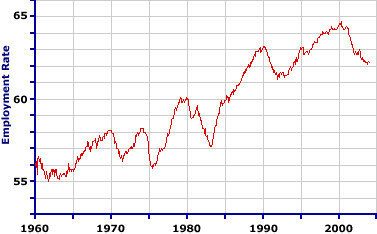
|
|
COMMON STOCK: The ownership shares in a corporation that have legal claim to the corporation's assets. Stock is usually dividend into two types, common stock and preferred stock. Preferred stock has first claim to the corporations net assets, and common stock comes in second. However, if a corporation has no preferred stock, the common stock has exclusive claim. Most stocks are negotiable and are traded one on a stock market.
Visit the GLOSS*arama
|
|


|

|
                           EMPLOYMENT RATE: The ratio of employed persons to the total civilian noninstitutionalized population 16 years old or older. Also termed the employment-population ratio, the employment rate is used as an alternative to the unemployment rate as an indicator of the utilization of labor resources. Because the employment rate is the ratio of employment to population, it does not suffer from underestimation problems attributable to discouraged workers and other unemployed persons that enter and exit the labor force. In particular, the unemployment rate goes up and down as people enter and exit the labor force, even though these folks have no affect on employment and production. When discouraged workers leave the labor force, the unemployment rate goes down, but the employment rate does not change. When high school and college students seek jobs during the summer months, the unemployment rate goes up, even though the employment rate does not change.| Employment Rate |  |
This chart illustrates the recent trend of the unemployment rate. Notice that while the overall trend is gradually upward, the rate does take a dip from time to time. These dips are the result of business-cycle contractions. A dip during the recessionary periods in the 2000s, 1990s, and 1980s is clearly seen in the chart. While the declines might not seem like much, keep in mind that each percentage point is a 1 percent of the total civilian noninstitutionalized population (which is about the 200 million people). As such, a drop from 62.8 percent to 61.8 percent is about 2 million people.The calculation of the employment rate is illustrated using this equation: | employment rate | = | employed
persons
total noninstitutionalized
civilian population | x 100 |
Suppose that the total noninstitutionalized civilian population is 206,000 people and the number of employed persons is 133,000. The employment rate is calculated as: | employment rate | = | 133,000
206,000 | x 100 | = | 64.6% |
The employment rate is closely associated with the labor force participation rate. The labor force participation rate is the ratio of the sum of both employed and unemployed to the total noninstitutionalized civilian population. The employment rate is simply the ratio of employed persons to the total noninstitutionalized civilian population. The connection between the employment rate and labor force participation rate is also noted by the general upward trend in the employment rate. In the late 1940s, the employment rate was in the mid-50 percent range. By the late 1990s, this rate had gradually risen to the mid-60 percent range. Much of this increase can be attributed to the increased participation of women in the labor force, which resulted from a change in the traditional role of women as housewives, stay-at-home mothers, and homemakers. The end result is that the economy has found employment for a larger fraction of the population, resulting in an increase in total production. The employment rate is also closely connected to what is termed the dependency ratio, which indicates the degree to which the entire population depends on those actively engaged in production. When the employment rate increases, society has more people working and producing and thus fewer dependents not working and producing. The burden placed on each provider is less when more people do the providing.

Recommended Citation:EMPLOYMENT RATE, AmosWEB Encyclonomic WEB*pedia, http://www.AmosWEB.com, AmosWEB LLC, 2000-2024. [Accessed: April 27, 2024].
Check Out These Related Terms... | | | | | | | | | | | | |
Or For A Little Background... | | | | | | | | | |
And For Further Study... | | | | | | | | | | | | | | | | | |
Related Websites (Will Open in New Window)... | | |
Search Again?
Back to the WEB*pedia
|



|

|
PURPLE SMARPHIN
[What's This?]
Today, you are likely to spend a great deal of time searching the newspaper want ads wanting to buy either a 50-foot blue garden hose or a turbo-powered vacuum cleaner. Be on the lookout for broken fingernail clippers.
Your Complete Scope
This isn't me! What am I?
|

|
|
Only 1% of the U.S. population paid income taxes when the income tax was established in 1914.
|

|
|
"Nothing is a waste of time if you use the experience wisely. " -- Auguste Rodin, Sculptor
|

|
EFTA
European Free Trade Association
|

|
|
Tell us what you think about AmosWEB. Like what you see? Have suggestions for improvements? Let us know. Click the User Feedback link.
User Feedback
|


|


